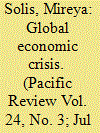| Srl | Item |
| 1 |
ID:
106005


|
|
|
|
|
| Publication |
2011.
|
| Summary/Abstract |
Political economists have long noted that the prospects for trade liberalization diminish in a climate of economic recession. A stagnant economy intensifies the burden of adjustment for non-competitive sectors and polarizes domestic trade politics. Not surprisingly, the global financial crisis has raised concerns of a substantial protectionist backlash, through the imposition of national measures that circumvent WTO disciplines such as anti-dumping or tied stimulus packages. The impact of economic crisis on regional integration is, however, more ambiguous and has not been explored systematically. On the one hand, policymakers may be pressed to renege on trade liberalization commitments on all fronts - also weakening the momentum to negotiate or implement free trade agreements (FTAs). On the other hand, policymakers may be tempted to 'insulate' their region from adverse global trends and may see FTAs as more amenable to political manipulation that shelters inefficient sectors. In order to shed light on the connection between external crisis and regionalist drive, this article assesses three main challenges East Asian elites confront in devising a regional trade bloc capable of acting as a growth locomotive: institutional fit, multilateralization, and architectural design. The track record of East Asian governments of negotiating FTAs to score diplomatic points abroad and ensure political survival at home - at the expense of maximizing economic gains through far-reaching liberalization - does not bode well for the magnitude of this challenge.
|
|
|
|
|
|
|
|
|
|
|
|
|
|
|
|
| 2 |
ID:
147550


|
|
|
|
|
| Summary/Abstract |
Holy Land Crusades were among the most significant forms of military mobilization to occur during the medieval period. Crusader mobilization had important implications for European state formation. We find that areas with large numbers of Holy Land crusaders witnessed increased political stability and institutional development as well as greater urbanization associated with rising trade and capital accumulation, even after taking into account underlying levels of religiosity and economic development. Our findings contribute to a scholarly debate regarding when the essential elements of the modern state first began to appear. Although our causal mechanisms—which focus on the importance of war preparation and urban capital accumulation—resemble those emphasized by previous research, we date the point of critical transition to statehood centuries earlier, in line with scholars who emphasize the medieval origins of the modern state. We also point to one avenue by which the rise of Muslim military and political power may have affected European institutional development.
|
|
|
|
|
|
|
|
|
|
|
|
|
|
|
|
| 3 |
ID:
102769


|
|
|
|
|
| Publication |
2011.
|
| Summary/Abstract |
We investigate changes in Asia's regional and global trade linkages and their influence on macroeconomic relationships among Asia, Europe and the USA. We first document changes in tripartite trade patterns and discuss stylized facts about East Asia's trade structure, with particular focus on the role of China. China plays a critical role in the rapidly expanding intra-Asian trade as an assembly and production center that supplies final goods for the advanced economies. However, China's trade shares in final goods with East Asia and in parts and components with Europe and the USA are rising, suggesting that the region's production chains are becoming increasingly integrated into the global business network. Empirical results from a panel vector autoregression model generally confirm increasingly mutual macroeconomic interdependence among East Asia, Europe and the USA. The findings suggest a future role for Asia as an important trade partner and balancing power in the world economy.
|
|
|
|
|
|
|
|
|
|
|
|
|
|
|
|